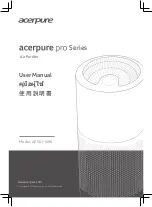
6 Installation
Installer reference guide
11
(A)RXP20~3 RXF20~35A2V1B
R32 split series
4P513661-2 – 2017.11
WARNING
▪ If the power supply has a missing or wrong N-phase,
equipment might break down.
▪ Establish proper earthing. Do NOT earth the unit to a
utility pipe, surge absorber, or telephone earth.
Incomplete earthing may cause electrical shock.
▪ Install the required fuses or circuit breakers.
▪ Secure the electrical wiring with cable ties so that the
cables do NOT come in contact with sharp edges or
piping, particularly on the high-pressure side.
▪ Do NOT use taped wires, stranded conductor wires,
extension cords, or connections from a star system.
They can cause overheating, electrical shock or fire.
▪ Do NOT install a phase advancing capacitor, because
this unit is equipped with an inverter. A phase
advancing capacitor will reduce performance and may
cause accidents.
WARNING
▪ All wiring MUST be performed by an authorised
electrician and MUST comply with the applicable
legislation.
▪ Make electrical connections to the fixed wiring.
▪ All components procured on the site and all electrical
construction MUST comply with the applicable
legislation.
WARNING
The backup heater MUST have a dedicated power supply
and MUST be protected by the safety devices required by
the applicable legislation.
WARNING
ALWAYS use multicore cable for power supply cables.
6
Installation
6.1
Overview: Installation
This chapter describes what you have to do and know on-site to
install the system.
Typical workflow
Installation typically consists of the following stages:
1
Opening the units
2
Mounting the outdoor unit
3
Connecting the refrigerant piping
4
Checking the refrigerant piping
5
Charging refrigerant
6
Connecting the electrical wiring
7
Finishing the outdoor unit installation
6.2
Opening the units
6.2.1
About opening the units
At certain times, you have to open the unit.
Example:
▪ When connecting the refrigerant piping
▪ When connecting the electrical wiring
▪ When maintaining or servicing the unit
DANGER: RISK OF ELECTROCUTION
Do NOT leave the unit unattended when the service cover
is removed.
6.2.2
To open the outdoor unit
DANGER: RISK OF ELECTROCUTION
DANGER: RISK OF BURNING
1×
2
1
2
6.3
Mounting the outdoor unit
6.3.1
About mounting the outdoor unit
When
The outdoor and indoor unit must be mounted before the refrigerant
piping can be connected.
Typical workflow
Mounting the outdoor unit typically consists of the following stages:
1
Providing the installation structure.
2
Installing the outdoor unit.
3
Providing drainage.
4
Preventing the unit from falling over.
5
Protecting the unit against snow and wind by installing a snow
cover and baffle plates. See "Preparing installation site" in
6.3.2
Precautions when mounting the outdoor
unit
INFORMATION
Also read the precautions and requirements in the
following chapters:
▪ General safety precautions
▪ Preparation
6.3.3
To provide the installation structure
Check the strength and level of the installation ground so that the
unit will not cause any operating vibration or noise.
Fix the unit securely by means of foundation bolts in accordance
with the foundation drawing.
Prepare 4 sets of M8 or M10 anchor bolts, nuts and washers (field
supply).
20 mm












































